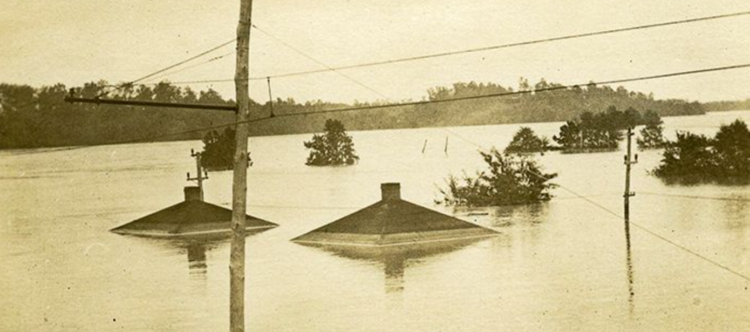
Houses submerged near Lookout Shoals in Catawba County / Duke Energy Archives
Jan. 20. By Tonya Rivens. During the holidays, you may have heard the words, “Over the river and through the woods to Grandmother’s house we go; the horse knows the way to carry the sleigh through the white and drifted snow.”
The song was originally a poem published by Lydia Maria Child in 1844 and she was referring to her own childhood memories.
Natives of Cornelius often say “over the river” when they cross the Catawba River from Mecklenburg to Lincoln County on Hwy. 73.
Prior to the Great Flood of 1916, the Catawba River was used mainly for agriculture. Torrential rain and two hurricanes within a week’s time in July of 1916 caused massive flooding.
More than 80 people died, hundreds of homes, businesses, roads, and railways were destroyed. The total cost of the damage was estimated at $480 million—more than $10 billion today.
The Catawba contains the most major dams of any North Carolina river.
By 1940, 10 dams backed up the lakes along the Catawba. Lake Norman was built in the 1960s.
Local history
During the 1960s, Cornelius native Wib Overcash, who is in his 90s, sold 72 acres to Duke Power for about $200 an acre. An acre of lakefront property is worth in the millions today.
Homes, bridges, mills, cemeteries, schools, churches, and an airplane are at the bottom of the Lake.
The original cemeteries of Hunters Chapel Episcopal Church, currently Hunters Chapel United Methodist Church, Cornelius Family and M.E. Zion were moved to higher ground.
Gladys Henderson, a 78-year-old member of Hunters Chapel, says that she remembers their original church was an old wooden building with holes in the floor. It was heated by a pot belly stove.
“We were surrounded by water and trees and the Holy Spirit was always present during church service,” Henderson says.
For the annual Homecoming, church members used wooden planks to make picnic tables for people to eat on.
Johnnie Lee Leazer’s grandfather owned 102 acres.
He remembers big fields of corn and cotton before Lake Norman.
“We would have mules pull our wagons to the cotton gin behind Potts Barber Shop,” says Leazer.
“The cotton would be sucked through a big pipe and the leaves, seeds and other matter would be removed. The price per pound was 39 cents,” he explains.
Leazer says the average person would pick 180-200 pounds of cotton by hand. He is also a member of Hunters Chapel and says the church driveway was red dirt. “When it rained, we had red mud,” he says.
“Everyone looked out for one another and would help push their cars out of the mud,” he added, explaining that he has lived in his home on John Connor since 1959.
“We didn’t move to the lake; the lake came to us.”
Top lake town
Today, Lake Norman is the largest man-made lake in the state with 520 miles of shoreline.
MSN/Lifestyle put Cornelius at No. 5 on the list of 10 best lake towns in the United States. MSN Reporter Clara Appelbaum says Cornelius is an “awesome: lake town:
“For city slickers, Cornelius, North Carolina, is the perfect town to enjoy lake living without sacrificing big city amenities. Located only half an hour from the bustle of Charlotte, Cornelius borders one of the most beautiful lakes in North Carolina, Lake Norman. While you’re there, check out Jetton Park, a beautiful 104-acre park on the lake, or enjoy a cold beer at one of the many local breweries in the area.”
Prior to Lake Norman, residents of Lincoln County and nearby areas would take Hwy. 16 to Beatties Ford Road, which is now John Connor Road in Cornelius, for the best route to Trade and Tryon in Charlotte.
Five miles of Beatties Ford is now under Lake Norman. But many natives continue to travel “over the river” to visit relatives, shop, worship and have fun.

Tonya Rivens is a multi-skilled journalist and is currently heard on Streetz 103.3/100.5 FM, blogs at tonyarivens.com.





